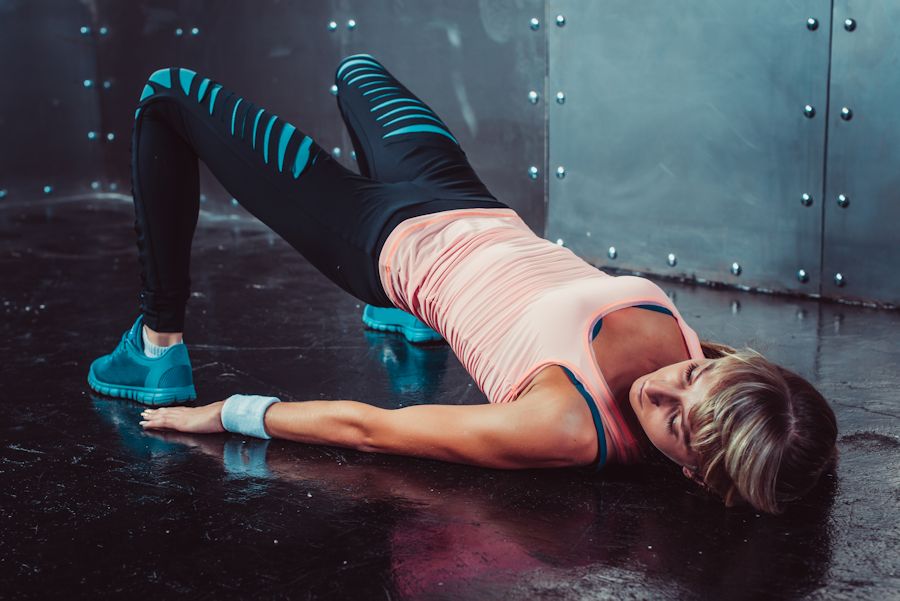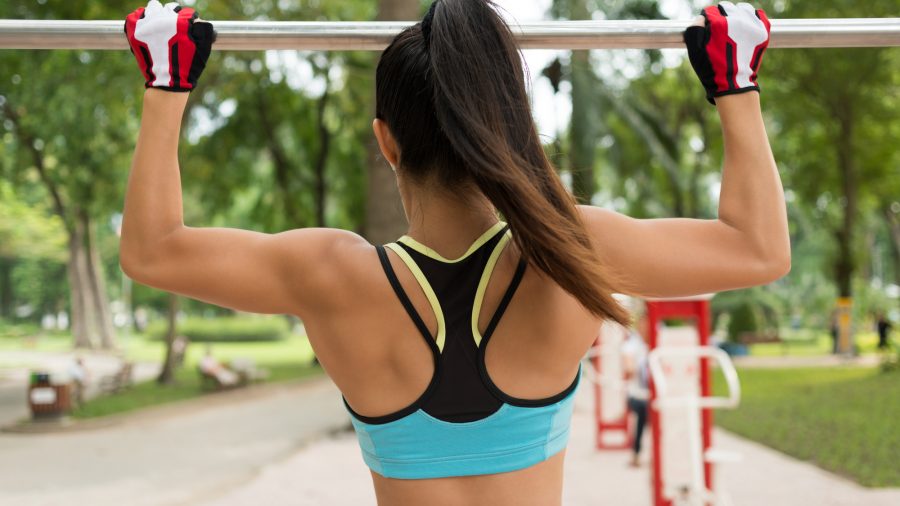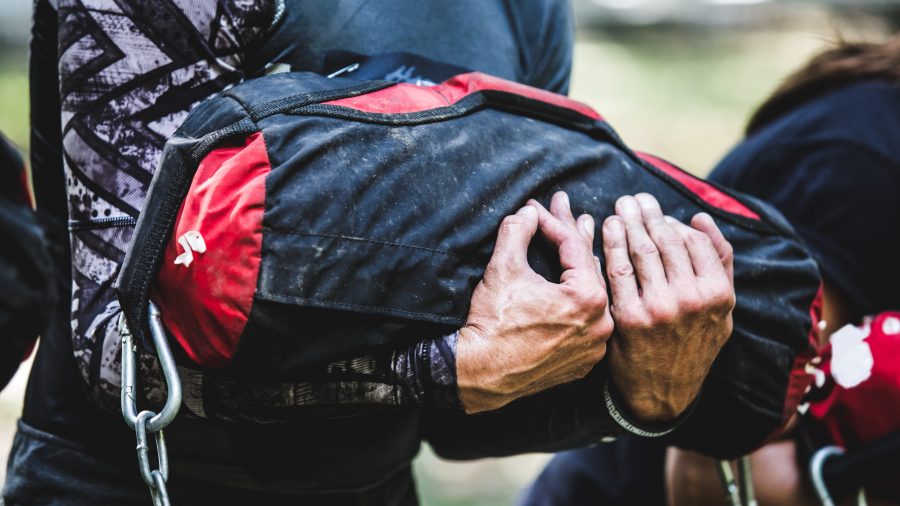Last Updated on October 8, 2018 by Nick

Bridge pose sporty woman doing fitness workout yoga stretching gymnastics exercise
Sciatica is a general term for pain which occurs due to pressure placed upon the sciatic nerve, which is responsible for the movement of the legs and feet.
Due to this, most common sciatic pain is felt as a shooting pain down the legs, sometimes to the feet, and at other times can be focused around the lower back or buttocks area.
In most healthy people, sciatic pain will remedy itself within 6 weeks, even in the event the pain is caused by a herniated disc in the spine.
For the elderly however, sciatic pain can be caused by worn down nerve tunnel sections between discs, caused mainly due to osteoarthritis, which can lead to constant pain.
Contents
What are the symptoms of sciatic pain?
Sciatic pain can be felt in many different forms, some of which people take as something fairly normal, all the way up to serious pain where by one is unable to walk.
Some feelings associated with sciatic pain include a warm or hot feeling in and around the:
- gluteus muscle (buttocks)
- aching pain in the region of the buttocks
- hamstring (back of the thigh) and/or calf muscles
- pins and needles in a region from the lower spine to the feet
- a severe increase in pain when coughing, sneezing, lifting or doing strenuous tasks
- and in more serious cases, pain in the ankle and/or foot, along with loss of power to the muscles of the leg and foot
Natural self-care techniques and equipment to remedy sciatica
Before heading down to the doctors or chemist for some pain killers, it is important to know that sciatica is caused by a injury to the spine, and while this may sound serious, it is actually extremely common.
Normally the injury will have occurred due to an event in your life which has caused neglect for the spine.
Except in cases of sciatica in the elderly, hence if you are experiencing sciatica and are younger than 70 years old, it is important to look to your everyday tasks and surroundings for the potential cause.
There are potential remedies you can put in place to begin to relieve the stress on your spine over the long term, and this often produces the best results in terms of ongoing relief of sciatica and preventing its recurrence.
Rest and recovery
Resting for around 30 minutes every 2 to 4 hours can provide some relief initially to sciatica, however it is important not to spend all your time in bed.
Taking a short 30 minutes out every few hours to obtain some pain relief in bed can be helpful to both the spine and the pain you are experiencing.
However, prolonged bed rest has been shown to provide no improvement in recovery time compared to staying active, and most studies agree prolonged bed rest is, if anything, likely to increase the recovery time of sciatic pain.
In terms of your sleep at night, poor quality beds and mattresses are often a leading cause of spinal injury and pain throughout the population.
A high quality mattress, such as a memory foam mattress, will provide correct posture during sleep, and provide significant benefits to the spine.
Along with allowing proper rest and recovery for the muscles within your body, many of which also play a key factor in cases of spinal injury.
Correct posture in seated positions
Another leading cause of back pain, including lumbar disc prolapse, and neck / shoulder injury, is incorrect posture when in a seated position.
Many people purchase office chairs and furniture based solely upon appearance, and the problem with this is that although they may look nice, they are likely not very good for your body.
That doesn’t mean you need to compromise on the look of the furniture however, just be sure to check that the furniture you purchase is also certified as ergonomic, which will provide you with the best support for your lower back, mid / upper spine, along with your shoulders and neck.
The use of ergonomic furniture is seriously lacking in both workplaces and peoples homes, even though this type of furniture has been around for decades, and can now be incorporated into furniture of good appearance.
Spending a bit more time and money on ergonomic seating will inevitably lead to money saved from prevention of recurring back pain, along with less sick days required off work, and general productivity around the home and in general due to pain prevention should also be taken into account when considering the price difference.
For office workers, ensuring your monitor is visible at eye level, without having to look up or down at the screen, is also a form of ergonomics (office ergonomics).
For people who often use their mobile phones, the majority also look down upon their screens, this can contribute to pain in the shoulders, neck and back too and should be considered if using the device for longer than a couple of minutes every hour or more.
Lower back exercises
There are also some general areas you should look at in prevention of sciatica, learning to do gentile exercises which strengthen the lower lumbar spinal region (lower back) is often the best treatment method by far.
It is important to note that almost all cases of sciatica and lower spine injury occur due to muscles either being too tense due to prolonged periods of inactivity, leading them to actually pull the spine out of place due to the tensile strength being placed in the wrong areas, or in cases such as injury while heavy lifting, this is often caused by a lack of strength in the lower back.
In both cases mentioned above, strengthening the lower back will prevent these two key issues, a strong back is less likely to become extremely tense, and also increased strength will prevent strain or disc prolapse during heavy lifting.
Often the two go hand in hand, so you may spend a lot of time seated, which leads to tense muscles, then do heavy lifting, where both tense and low strength muscles cause injury.
Lower back exercises can be obtained from a single session with a personal trainer, a single session with a physiotherapist, or a lot of sources online usually list information on lower back exercises.
Just be sure if obtaining from online that the source is reputable, as there are a lot of people making up new exercises without any proof of their success rates.
Some methods of yoga practice can also benefit the lower back in strength and loosening and repositioning of the muscles which attach to the spine.
Another extremely good option, provided your lower back pain is not due to a prolapsed disc, and solely muscular, is treatment from a myotherapist, or musculoskeletal therapist, these two treatments use massage and manipulation to loosen and reposition your muscles, which results in relieving lower back pain.
This treatment however is often not beneficial if the pain is caused by a prolapse, as the rupture of the spinal disc will be the cause of the pain in these cases, rather than the muscles themselves, hence this form of treatment can only be done either after the rupture has healed, or where no rupture of the spinal discs exists.
Correct standing posture
Retaining a correct posture throughout the entire day provides extremely high relief upon the lower back, correct posture varies depending on the type of activity you are doing, the main two areas however are standing and sitting.
Full details on correct posture can be obtained from physiotherapists or through online sources, just ensure the source you use is reputable.
Shoes also play a key role in preventing and limiting sciatic pain. Standing for long periods of time often places a high load of stress upon the lower back.
In recent years a number of shoes specifically targeting sciatica and back pain have been released, these provide a soft padding innersole with heel support, effectively providing a small cushion between the weight of the body and the ground below.
This provides a small amount of relief to the lower back and over time can help prevent sciatica and back pain, especially in people who work in employment areas which require standing for most of the day.
Another option to specific shoes for sciatica and lower back pain, is also replaceable innersoles, these can be found online or at most shoe shops and chemists, these are a gel and rubber innersole which provides similar support to the shoes mentioned above, with the benefit of being removable and interchangeable with your own choice of shoes.
Water Immersion Treatments
Both lower back pain and sciatica respond well to water immersion to relieve and recover from painful injuries.
Taking a warm bath once to twice per day while experiencing lower back pain and sciatica can assist the body in speeding up the healing process, it also helps to regulate any inflammation.
Spa baths can also be used in the same way during times of pain.
Regular warm baths once a week during periods where you are pain free also helps the body to relax muscles and can be used as a means of pain management / maintenance.
Floatation therapy is also a proven method to assist in recovery and pain management of sciatica.
Floatation involves an enclosed spa filled with a 50% Epsom salt to water ratio, which allows the body to float to the surface once laying back in the water.
A number of research studies have found floatation tanks to provide significant benefits for muscular injury recovery and chronic pain suffers, especially those with back pain and sciatica. Floatation centres can be found in most major cities worldwide.
Swimming also takes a lot of stress off the lower back, and visiting a local indoor heated swimming pool can help provide relief from lower back pain and sciatica, an added benefit of swimming is that the exercise gained is often felt throughout the entire body.
Bottom line, low gravity environment provided by the water allows exercise with limited impact upon the weight applied to the lower back, making it easier than other methods of exercise during times when pain is severe.




